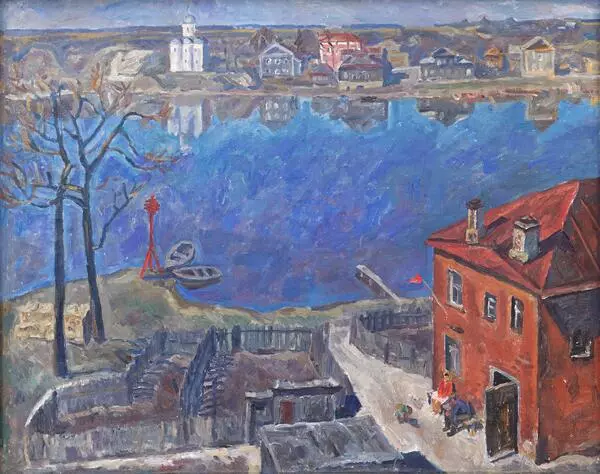In the cultural heritage of each country there are monuments beloved and known by everyone. They can be big buildings of architectural complexes, like the ensemble of the Red Square, or smaller churches and monasteries.
One of the religious symbols of Russia is the Church of the Intercession of the Holy Virgin on the Nerl River. The monument of old Russian architecture of the 12th century, according to the annals’ data of pre-Mongolian period, was dedicated to the Mother of God. The church is situated in Vladimir district near Bogolyubov village. The remarkable monument is made of white stone and is an example of a candle-like church. It is decorated with various reliefs with griffons, lions, lion heads. One of the particularities of the view is the fact that the church stands alone by the side of the Nerl River. The territory of Bogolyubovsky field is in the UNESCO World Heritage List. In spring the river often overflows, and the church gets surrounded by small ponds.
It’s no surprise that landmark was depicted by Eduard Bragovsky, the People’s Artist of the USSR. The graduate of Moscow Art Institute, Eduard Bragovsky was one of the Sixtiers painters, the professionals of the Severe Style. As many other painters of the time, he contemplated about the beauty of nature and architecture of old Russian cities, such as Volkhov, Rostov, Zagorsk. The temple subject often appeared in Bragovsky’s works throughout his own creative career.
Spring at the Nerl from the collection of the Kurgan Regional Art Museum was painted in 1980. It participated in the republican exhibition Motherland’s Monuments in the Works of the Painters from the Russian Federation in Moscow, Yaroslavl, and Tula in 1980-1981. This exhibition showed a special reflection of the painters on the new law for the Preservation of Historical and Cultural Monuments, their concerns about the future of the monuments and the history of their country.
The first thing the viewer sees are the many tones of blue colour in depiction of the sky, water, and even the church. “In my painting I mostly use cold colours, such as blue, dark blue, green, blue green, aquamarine. This is how my eye sees”, wrote the painter. Most part of the canvas is occupied by the high blue sky with the clouds running in the wind, it is also reflexed in the cold spring water. The church occupies very little space, but the author made it look solid, even grown into the soil. It can be an allegory of the image of Russia or the human faith in general.
This work has a version made in 1977, now in the collection of the State Tretyakov Gallery. It is distinctly different with its light palette, impressionist manner and smaller size. In the later version the painter thickened the colours, made them colder. The atmosphere became more philosophical, tense. This painting takes one of the most honourable places in the permanent exposition of the museum and has been there for almost 40 years already.
One of the religious symbols of Russia is the Church of the Intercession of the Holy Virgin on the Nerl River. The monument of old Russian architecture of the 12th century, according to the annals’ data of pre-Mongolian period, was dedicated to the Mother of God. The church is situated in Vladimir district near Bogolyubov village. The remarkable monument is made of white stone and is an example of a candle-like church. It is decorated with various reliefs with griffons, lions, lion heads. One of the particularities of the view is the fact that the church stands alone by the side of the Nerl River. The territory of Bogolyubovsky field is in the UNESCO World Heritage List. In spring the river often overflows, and the church gets surrounded by small ponds.
It’s no surprise that landmark was depicted by Eduard Bragovsky, the People’s Artist of the USSR. The graduate of Moscow Art Institute, Eduard Bragovsky was one of the Sixtiers painters, the professionals of the Severe Style. As many other painters of the time, he contemplated about the beauty of nature and architecture of old Russian cities, such as Volkhov, Rostov, Zagorsk. The temple subject often appeared in Bragovsky’s works throughout his own creative career.
Spring at the Nerl from the collection of the Kurgan Regional Art Museum was painted in 1980. It participated in the republican exhibition Motherland’s Monuments in the Works of the Painters from the Russian Federation in Moscow, Yaroslavl, and Tula in 1980-1981. This exhibition showed a special reflection of the painters on the new law for the Preservation of Historical and Cultural Monuments, their concerns about the future of the monuments and the history of their country.
The first thing the viewer sees are the many tones of blue colour in depiction of the sky, water, and even the church. “In my painting I mostly use cold colours, such as blue, dark blue, green, blue green, aquamarine. This is how my eye sees”, wrote the painter. Most part of the canvas is occupied by the high blue sky with the clouds running in the wind, it is also reflexed in the cold spring water. The church occupies very little space, but the author made it look solid, even grown into the soil. It can be an allegory of the image of Russia or the human faith in general.
This work has a version made in 1977, now in the collection of the State Tretyakov Gallery. It is distinctly different with its light palette, impressionist manner and smaller size. In the later version the painter thickened the colours, made them colder. The atmosphere became more philosophical, tense. This painting takes one of the most honourable places in the permanent exposition of the museum and has been there for almost 40 years already.




